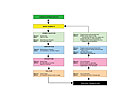

Figure 1.
There are many reasons to create a clear and concise corporate strategy.
- It establishes an overall vision and direction for the company.
- It integrates and focuses all business functions (sales, marketing, production, technology, etc.) on one set of goals and objectives.
- It maximizes the effectiveness of R&D efforts by analyzing and allocating technology resources based on market potential and competitive advantage. It can also impact success rates and speed to market for projects, ensuring that growth and profit objectives are met.
- It identifies clear commercial objectives and guides the organization in creating tactical plans.
ChemQuest has developed a proprietary model to analyze strategic alignment within an organization. This involves a number of critical success factors to evaluate business units, market segments and product development projects. These include the following.
- For projects:
- Technical feasibility
- Commercial feasibility
- Value to the customer
- Market attractiveness
- Competitive advantage
- Cost attractiveness
- Total sales for the last full year
- Percent profit for the full year (or current year projected)
- Total profit dollars for the last full year
- Cumulative projected three-year growth in profit dollars
- Overall strategic fit
To begin to understand this problem, let’s examine how sales activities have historically flowed within corporations (see Figure 1). This traditional one-directional flow of information becomes a source for strategy-tactic misalignment, as it is predicated on the following.
- The assumption that the strategic plan is sufficiently understood by all to be adequately factored into the sales plan, the territory plan, the account plan and the individual call plan.
- The assumption that, in the heat of the day-to-day “battle,” it is even remembered that a strategic plan exists.
- The assumption that sales and marketing activities happen in a “perfect vacuum,” devoid of outside influence from the economy, the competition, the customer, etc.
- The assumption that “no news is good news.”

Figure 2.
It is important to note that each step in the sales process has defined measures and metrics that are created with the corporate strategy in mind. For example, if the strategy is to limit efforts in one market segment in favor of another that is deemed to have better growth prospects, there is now a mechanism to gauge whether resources are being used in line with the strategy. This procedure thus allows the strategy to be factored into all facets of the sales process down to the call plan where the strategy is put into place.
The other important feature to note is the strategic feedback loop. This should be self-evident; however, many companies do not require a regular and steady flow of market information from their sales organization. Unfortunately, this deprives the corporation of valuable intelligence that is vital to gauging the success of the strategy, and crucial to making any strategic adjustments that are necessary in response to changing market dynamics, technology developments, competitive responses, etc.
We have identified a number of critical success factors that impact a strategy. Many of those require input from sales, and we believe that no strategy can be successful without that crucial input. Such things as value to the customer, market attractiveness and competitive advantage can only be understood if the sales process has measures and metrics built into the tactical plans that are aimed at gathering the requisite feedback.
These inputs are also important in making adjustments to the strategy itself. To paraphrase the famous Prussian General von Clausewitz in his classic bookOn War, no plan survives contact with the enemy. Strategic plans are never meant to be static, particularly in such a competitively dynamic global economy. Thus, companies that don’t recognize the need to continually evaluate and adjust their strategy as necessary based on solid and timely feedback from the marketplace are vulnerable to being eclipsed in that same marketplace.
So, unless a company institutes measures and metrics within its sales process that are directly aligned with the goals and objectives outlined within its strategic plan, it risks finding itself misaligned - with sales marching to a differ cadence than the rest of the corporation. In addition to the resulting frustrations, there is a further risk that the corporation may fail to adjust and adapt to changes in the market because it failed to see those changes coming.

Jones
For more information, phone (513) 469-7555 or visit www.chemquest.com.

